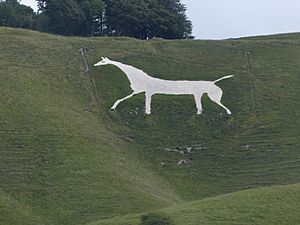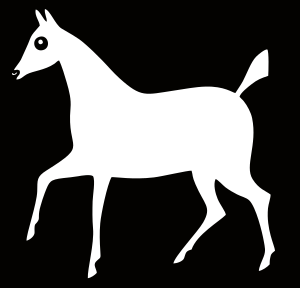Cherhill White Horse facts for kids
The Cherhill White Horse is a giant horse shape carved into a hillside in Wiltshire, England. It's located about 3.5 miles east of a town called Calne. This amazing artwork was made in the late 1700s. It is the third oldest of its kind in Great Britain. Only the Uffington White Horse and the Westbury White Horse are older. Sometimes, people also call it the Oldbury White Horse.
Contents
Where to Find the Cherhill White Horse
The Cherhill White Horse faces towards the north-east. It lies on a very steep part of Cherhill Down. Just above it is an old earthwork called Oldbury Castle.
You can easily see the horse from the A4 road. It is also visible from the nearby village of Cherhill. A great spot to view it is from a special parking area (lay-by). This lay-by is next to the A4 road, where the road goes below the horse. From there, a path goes up the hill right to the horse.
Close to the horse, there is a tall stone pillar. It is called the Lansdowne Monument. You can see this monument in some pictures of the White Horse.
Why Was the Cherhill White Horse Made?
The Cherhill horse might have been inspired by another white horse. This was the first one in Wiltshire, located at Westbury. It had just been updated when the Cherhill horse was made.
The older Westbury horse has a less clear history. The Uffington White Horse in Oxfordshire is much older. We know it dates back to the Bronze Age. But the Westbury horse was first mentioned in 1742.
One idea is that the first Wiltshire horse celebrates a big victory. This was Alfred the Great's win over the Danes in 878. Another idea is that it showed loyalty to the new royal family. This was the House of Hanover in the early 1700s. The white horse was a symbol for them. It can be hard to know for sure why these hillside horses were created.
History of the Cherhill White Horse
Dr. Christopher Alsop from Calne first created the Cherhill horse in 1780. He made it by removing the grass to show the white chalk underneath. The horse was originally about 165 feet (50 meters) long. It was also about 220 feet (67 meters) tall.
Dr. Alsop was known as "the mad doctor." He is said to have directed the work from far away. He shouted instructions through a megaphone from a hill below. His design might have been influenced by his artist friend, George Stubbs. Stubbs was famous for his paintings of horses.
Since 1780, the horse has been cleaned many times. This cleaning is called 'scouring'. In 1935, workers covered it with a mix of concrete and chalk. It was cleaned again in 1994.
A big restoration happened in 2002. The Cherhill White Horse Restoration Group did this work. They added 160 tonnes of new chalk to the surface. The edges were re-cut. They also added wooden frames to hold the chalk in place. The National Trust helped with this work. They gave an £18,000 grant. Today, the surface is made of packed chalk. The edges of the horse are very clear.
In the 1800s, the horse had a shiny glass eye. It was made from bottles pushed into the ground. A farmer and his wife added these bottles. But by the late 1800s, they were gone. In the 1970s, a local youth group added a new eye. It was also made of glass bottles. But these disappeared too. Now, the eye is made of stone and concrete. It sits a bit higher than the chalk surface around it.
In 1922, someone noted that the horse needed cleaning badly. This was because of the Great War. Many such things had been neglected. But a local lady offered to help restore it. The Lord of the Manor used to be its caretaker.
In 1937, for the coronation of King George VI, the horse was lit up. The letters GE were lit in red lights above it. Power came from a generator at the bottom of the hill. The red letters lit up for five seconds. Then the floodlights came on for ten seconds. This pattern kept repeating.
Thirteen white horses are known to have existed in Wiltshire. Eight of these can still be seen today. The others have been covered by grass over time.
The hill above the horse now belongs to the National Trust. The Alton Barnes White Horse was even based on the Cherhill White Horse.
Images for kids
-
Cherhill white horse and the Lansdowne Monument.





